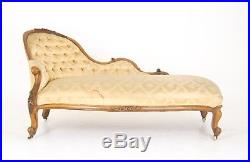

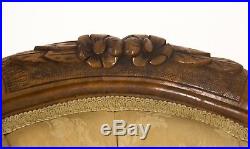

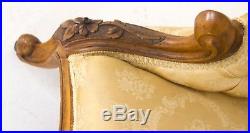

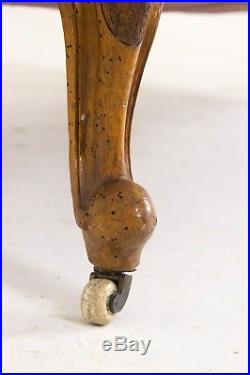

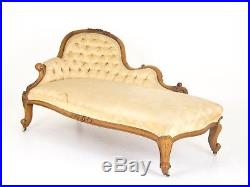
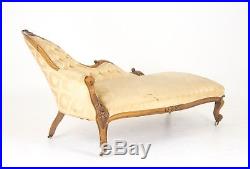
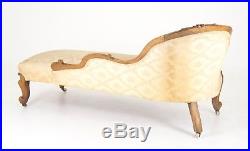
Antique Chaise Lounge, Victorian Settee, Walnut, Scotland 1860, Antique Furniture, B917. Solid Walnut Construction, Carved Walnut Frame. Shaped Back, Shaped Scroll Ends. Uniquely Shaped Back Later Covering with Velour Styled Fabric. Ending on Cabriole Legs with Original Castors. Fame and Upholstery in Fair Condition, needs to be recovered. 65″w x 33″d x 31″h, 15″ seat height. Vintage and Antique Sofas and Chaise Lounges. Simply put, a chaise lounge (long chair) is an upholstered sofa in the shape of a chair that is long enough to support the legs. In modern French the term chaise longue can refer to any antique sofa long reclining chair; even an outdoor chair such as a deckchair. A literal translation in English is long chair. In the United States the term lounge chair is also used to refer to any long reclining chair. In the United States, chaise longue is nearly always written chaise lounge the first constituent a spelling pronunciation, the second a 19th-century folk-anagrammatic adaptation of the French word longue. Since the 1950s the chaise longue has been somewhat associated with psychoanalysis and many psychoanalysts continue to keep chaises longues in their offices for use in therapy. There is thought to be some medicinal and psychological benefit to laying back on a piece of furniture and perhaps beginning to emulate falling asleep: taking the patient to another slighthly altered state. Victorian Furniture, History and Style. In the history of the United Kingdom, the Victorian era was the period of Queen Victorias reign, from 20 June 1837 until her death on 22 January 1901. The era followed the Georgian period and preceded the Edwardian period, and its later half overlaps with the first part of the Belle Epoque. Era in Continental Europe. Defined according to sensibilities and political concerns, victorian parlor chairs the period is sometimes considered to begin with the passage of the 1832 Reform Act. The period is characterised as one of relative peace among the great powers of the world (as established by the Congress of Vienna), increased economic activity, refined sensibilities and a full sense of great national self-confidence for Great Britain. Ideologically, the Victorian era witnessed resistance to the rationalism that defined the Georgian period and an increasing turn towards romanticism and mysticism with regard to religion, social values, and arts. The Victorian era, in the second half of the 19th century, commonly used walnut, mahogany, rosewood and dark colors; often accented with floral carvings. The period is known for its interpretation and eclectic revival of historic styles mixed with the introduction of middle east and Asian influences in furniture, fittings, and interior decoration. The Arts and Crafts movement, the aesthetic movement, Anglo-Japanese style, and Art Nouveau styles all have their beginnings in the late Victorian era and gothic period. From a design perspective; interior decoration and design of the Victorian era were noted for their orderliness and ornamentation. A home of this period was idealistically divided into rooms, (getting away from the one room homes of previous times) and these new rooms featured both public and private spaces carefully delineated and separated. Importance of the Rooms in the Home. In a Victorian home the parlor was considered to be the most important room and was the showcase for the homeowners where guests were entertained. A bare room was considered to be in exceptionally poor taste, so each and every surface was filled with victorian parlor chairs objects that reflected the owners individual proclivities, interests and aspirations. Victorian parlor chairs often with fabulous ornamentation, would be displayed front and center for the most valued guests. Common chair elements included oval backs and ornamentation. After the parlor, the dining room was the second-most important room in the house. In this room, the sideboard was most often the focal point of the dining room and very sumptuously adorned. Victorian dining tables and their matching chairs could be quite ornate as well. Victorian design in general is widely viewed as having indulged in a grand excess of embellishment. Bedroom design typically followed suit also. Top plates and marble tops on tables and nightstands and fabrics and wall coverings with well expressed motives and intense coloration. Often, draperies were of sumptuous fabrics and featured fringing. Ornaments like chandelier and sumptuous carpets, paintings and mirrors with rich frames were lovely added details. This is the right style for your bedroom; make it lovely and charming using Victorian themed details. The item “Antique Chaise Lounge, Victorian Settee, Walnut, Scotland 1860, B917″ is in sale since Saturday, February 17, 2018. This item is in the category “Antiques\Furniture\Sofas & Chaises\1800-1899″. The seller is “heatherbraeantiques” and is located in Bellingham, Washington. This item can be shipped worldwide.
- Style: Victorian
- Material: Walnut
- Type: Settee
- Height: 31″
- Width: 65″
- Depth: 33″
- Region of Origin: Scotland
- Original/Reproduction: Original
Comments are closed.